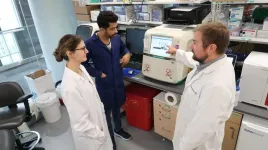(Press-News.org) Toddlers in the UK obtain nearly half (47%) of their calories from ultra-processed foods (UPFs), and this rises to 59% by the age of seven, according to a new study led by UCL researchers.
The study, published in the European Journal of Nutrition, looked at data from 2,591 children born in the UK in 2007 and 2008 whose parents recorded what their children ate and drank over three days.
The most common UPFs consumed by the toddlers – who were 21 months when their parents recorded their diets – were flavoured yoghurts and wholegrain breakfast cereals, products typically seen as healthy. By the age of seven, the most common UPFs were sweet cereals, white bread and puddings.
Lead author Dr Rana Conway, of the UCL Institute of Epidemiology & Health Care, said: “Ultra-processed foods are not all bad for our health and the foods typically eaten by the toddlers in our study are ones that are seen as quite healthy.
“However, some wholegrain cereals and flavoured yoghurts have high levels of added sugar and salt and our study found that toddlers who consumed more ultra-processed foods also had a higher intake of these ingredients.
“This is concerning, especially as toddlers in general consume more added sugar and salt than is recommended.
“Aside from sugar and salt, a diet that includes a lot of ultra-processed food is less likely to get children used to the natural flavours of whole foods and therefore less likely to encourage healthy eating later in life.”
Senior author Professor Clare Llewellyn, of the UCL Institute of Epidemiology & Health Care, said: “Eating patterns in the early years are important, as they help set habits that can persist through childhood and into adulthood. This was reflected in our findings, with 21-month-olds who ate more ultra-processed foods also likely to be higher consumers of ultra-processed foods at the age of seven.”
The researchers analysed data from the Gemini twin cohort study, using the Nova classification to divide the food and drink consumed into four groups: unprocessed or minimally processed foods (eggs, milk, vegetables, fish and fruit); processed culinary ingredients (salt, butter and oil); processed foods (tinned fish, peanut butter and cheese); and UPFs (cereals, yoghurts, industrially made sliced bread, biscuits, sausages, crisps).
UPFs are typically industrially produced and contain ingredients not used or very rarely used in home cooking, such as emulsifiers, colourings and sweeteners.
Toddlers were divided into five groups according to their ultra-processed food intake. The research team found that toddlers in the lowest UPF group consumed 28% of their calories from UPFs, while for toddlers in the highest of the five groups this was 69%.
They also found that ultra-processed foods consumed at 21 months predicted UPF consumption at seven years old. Toddlers who consumed the most UPFs were 9.4 times more likely to be in the highest UPF-consuming group at age seven compared to toddlers who consumed the lowest proportion of UPFs. The research team said this may be partly attributable to the “hyperpalatable” nature of these UPFs, as they tend to be foods higher in fat, sugar and/or salt.
In all five UPF groups, the toddlers’ consumption of free sugars exceeded the UK government recommended maximum of 5% of daily calorie intake. In the two highest UPF groups, added sugar intake exceeded 10% on average.
The researchers called for policies to redress the balance of children’s diets towards a lower proportion of UPFs, such as restricting the promotion of unhealthy foods marketed towards children, adding warning labels to products (e.g. those that are high in sugar), and subsidising fresh and minimally processed food.
Dr Conway said: “It’s not easy to feed children healthily in our current food environment. Highly processed foods are often cheaper than the foods parents would like to give their children, such as fresh fruit and vegetables.
“Also, despite labels suggesting they’re a healthy choice, ultra-processed foods marketed for children often contain too much sugar and salt. This makes it harder for parents to make healthy choices.”
In the paper, the research team also said there was a range of commercial products intended for young children that would not be classified as a UPF as they did not contain UPF-style ingredients but mimicked UPFs in terms of textures. These might include vegetable sticks or puffs or snacks resembling cookies.
Early exposure to these foods, the researchers wrote, was unlikely to encourage consumption of vegetables, even if the foods’ nutritional content was healthy (i.e., they did not include added sugar or salt).
In their study limitations, the researchers noted that people of white ethnicity and a higher socioeconomic status were over-represented in their population sample compared to the UK population as a whole.
END
Toddlers get nearly half their calories from ultra-processed foods
Toddlers in the UK obtain nearly half (47%) of their calories from ultra-processed foods (UPFs), and this rises to 59% by the age of seven, according to a new study led by UCL researchers
2024-10-04
ELSE PRESS RELEASES FROM THIS DATE:
Detroit researchers to examine links between bacterial infections, environmental pollution and preterm birth
2024-10-03
DETROIT — A new grant will help Wayne State University researchers explore the links between bacterial infections, the environmental factors that increase their susceptibility and the risk of preterm birth.
The five-year, $2,858,821 grant from the National Institute of Environmental Health Sciences of the National Institutes of Health, “PFAS increases susceptibility to infection-mediated preterm birth,” will be led by Michael Petriello, Ph.D., assistant professor in Wayne State’s Institute of Environmental Health Sciences and Pharmacology in the School of Medicine.
Petriello hopes that the team’s studies will identify critical pathways responsible ...
In lab tests, dietary zinc inhibits AMR gene transmission
2024-10-03
Highlights:
Antimicrobial resistance is a growing threat.
Bacteria exchange AMR genes in the gut via circular genetic material called plasmids.
In lab experiments, bacteria transferred plasmids with AMR genes in the presence of zinc at reduced or nonexistent rates.
Stopping the transfer without killing microbes may help reduce AMR without disrupting the gut microbiome.
Washington, D.C.—Genes responsible for antimicrobial resistance (AMR) can spread from microbe to microbe through circular genetic material called plasmids, and ...
Two UMD Astronomy space probes advance to next round of $1 billion NASA mission selection
2024-10-03
On October 3, 2024, NASA announced that two space probes proposed by University of Maryland astronomers have advanced to the next round of consideration for a $1 billion mission slated to launch into orbit in 2032.
The selected probes include the Advanced X-ray Imaging Satellite (AXIS) mission with UMD Astronomy Professor Christopher Reynolds as its principal investigator and the PRobe far-Infrared Mission for Astrophysics (PRIMA) with UMD Astronomy Professor Alberto Bolatto as a co-investigator and NASA Goddard Space Flight Center researcher and UMD Astronomy ...
New MSU research sheds light on impact and bias of voter purging in Michigan
2024-10-03
MSU has a satellite uplink/LTN TV studio and Comrex line for radio interviews upon request.
Images and Podcast
EAST LANSING, Mich. – In recent years, some states have prioritized purging their voter rolls of those who have passed away or moved out of state. During election season, there is often increased discussion about the necessity and impact of these actions. Voter purging can be an important step for creating election integrity, but others have raised concerns about how the process is conducted and who it targets.
So, are there negative effects of voter purging? Researchers from Michigan State University wanted to find out — especially ...
Funding to create world's first ovarian cancer prevention vaccine
2024-10-03
In this study, the Cancer Research UK-funded scientists will establish the targets for the vaccine. They will find out which proteins on the surface of early-stage ovarian cancer cells are most strongly recognised by the immune system and how effectively the vaccine kills mini-models of ovarian cancer called organoids.
If this research is successful, work will then begin on clinical trials of the vaccine. The hope is that in the future, women could be offered this vaccine to prevent ovarian cancer in the first place.
There are around 7,500 new ovarian ...
Scientists develop novel method for strengthening PVC products
2024-10-03
COLUMBUS, Ohio – Researchers have developed a way to make one type of plastic material more durable and less likely to shed dangerous microplastics.
The study identified a secure way to attach chemical additives to polyvinyl chloride (PVC).
Found in everything from toys, construction supplies and medical packaging, PVC plastics currently rank third among the most used plastics worldwide. Despite its widespread use, pure PVC is brittle and sensitive to heat, and manufacturers can only utilize it after stabilizing its properties with other chemicals.
However, these additives, or plasticizers, ...
Houston Methodist part of national consortium to develop vaccine against herpesviruses
2024-10-03
Houston Methodist researchers will be part of a national consortium funded by an up to $49 million award from the U.S. Government’s Advanced Research Projects Agency for Health (ARPA-H) to develop a vaccine against two of the most common and destructive strains of herpesviruses that latently infect a majority of Americans and can lead to acute infections, multiple forms of cancer, autoimmune disease and birth defects.
The award is part of ARPA-H’s Antigens Predicted for Broad Viral Efficacy through Computational Experimentation (APECx) program and will fund the America’s SHIELD project ...
UT Health San Antonio School of Dentistry earns first NIH grant under new center for pain therapeutics and addiction research
2024-10-03
SAN ANTONIO, Oct. 3, 2024 – The School of Dentistry at The University of Texas Health Science Center at San Antonio (UT Health San Antonio) earned the first National Institutes of Health grant under its new Center for Pain Therapeutics and Addiction Research, addressing pain in patients with head and neck carcinoma.
The nearly $600,000 grant by the NIH’s National Institute of Dental and Craniofacial Research will address this critical pain issue that significantly impairs quality of life. Many head and neck carcinoma patients require opiate pain management, but tolerance develops quickly, requiring new pain ...
Do MPH programs prepare graduates for employment in today's market? Mostly yes, but who is hiring may be surprising
2024-10-03
Public health degree programs provide key competencies demanded by employers, but graduate employability could be improved by using more real-time data from employer job postings, according to a new study at Columbia University Mailman School of Public Health. This could help public health schools and programs ensure that graduates obtain specific technical skills listed in job postings, meet current employer needs, and prepare graduates for the demands of today’s labor market. The findings are published in the American Journal of Public Health.
The competencies required for the ...
New article provides orientation to using implementation science in policing
2024-10-03
Since the 2020 murder by Minneapolis police of George Floyd brought nationwide calls for change amid concerns that prevailing practices were not grounded in evidence and created harm, policing has been in turmoil. Implementation science (IS) involves integrating effective and evidence-based innovations into routine practice in fields like health care. Yet despite its potential, IS—and specifically, evidence-based policing (EBP)—remain vastly understudied and unused in police settings. In a new article, researchers provide an orientation to these issues ...
LAST 30 PRESS RELEASES:
First Editorial of 2026: Resisting AI slop
Joint ground- and space-based observations reveal Saturn-mass rogue planet
Inheritable genetic variant offers protection against blood cancer risk and progression
Pigs settled Pacific islands alongside early human voyagers
A Coral reef’s daily pulse reshapes microbes in surrounding waters
EAST Tokamak experiments exceed plasma density limit, offering new approach to fusion ignition
Groundbreaking discovery reveals Africa’s oldest cremation pyre and complex ritual practices
First breathing ‘lung-on-chip’ developed using genetically identical cells
How people moved pigs across the Pacific
Interaction of climate change and human activity and its impact on plant diversity in Qinghai-Tibet plateau
From addressing uncertainty to national strategy: an interpretation of Professor Lim Siong Guan’s views
Clinical trials on AI language model use in digestive healthcare
Scientists improve robotic visual–inertial trajectory localization accuracy using cross-modal interaction and selection techniques
Correlation between cancer cachexia and immune-related adverse events in HCC
Human adipose tissue: a new source for functional organoids
Metro lines double as freight highways during off-peak hours, Beijing study shows
Biomedical functions and applications of nanomaterials in tumor diagnosis and treatment: perspectives from ophthalmic oncology
3D imaging unveils how passivation improves perovskite solar cell performance
Enriching framework Al sites in 8-membered rings of Cu-SSZ-39 zeolite to enhance low-temperature ammonia selective catalytic reduction performance
AI-powered RNA drug development: a new frontier in therapeutics
Decoupling the HOR enhancement on PtRu: Dynamically matching interfacial water to reaction coordinates
Sulfur isn’t poisonous when it synergistically acts with phosphine in olefins hydroformylation
URI researchers uncover molecular mechanisms behind speciation in corals
Chitin based carbon aerogel offers a cleaner way to store thermal energy
Tracing hidden sources of nitrate pollution in rapidly changing rural urban landscapes
Viruses on plastic pollution may quietly accelerate the spread of antibiotic resistance
Three UH Rainbow Babies & Children’s faculty elected to prestigious American Pediatric Society
Tunnel resilience models unveiled to aid post-earthquake recovery
Satellite communication systems: the future of 5G/6G connectivity
Space computing power networks: a new frontier for satellite technologies
[Press-News.org] Toddlers get nearly half their calories from ultra-processed foodsToddlers in the UK obtain nearly half (47%) of their calories from ultra-processed foods (UPFs), and this rises to 59% by the age of seven, according to a new study led by UCL researchers


